League of Legends is one of the most popular online games
League of Legends (or LoL for short) is one of the most important and iconic games for the online entertainment industry along with Counter Strike, World of Warcraft, and Dota 2. And with the latter two it has something in common, namely the Defense of the Ancients modification. First it appeared in Warcraft III: Reign of Chaos, and then formed the basis of Dota and League of Legends. About Dota 2 we've already told, and now it's turn of LoL. So what's the good of it, what's the history of its creation, what are its modes and champions, how it differs from the "Dota" and why the "league" is still played by thousands of players around the world?
History of creation and success
Brandon "Ryze" Beck and Mark "Tryndamere" Merrill went to University of Southern California together, and they decided to play games there. Plans were big, so the choice fell on the most popular modification DotA Allstars for Warcraft III: The Frozen Throne. Guys decided to release on its basis an independent project. And for that they invited Steve "Guinsoo" Fick, the author of DotA Allstars, and Steve "Pendragon" Mescon, the administrator of the official support base for it. So at the end of 2005 the development of League of Legends began, and a year later Riot Games Inc. opened a studio under it.
In 2008, the game was officially announced and released a year later. Bet played - LoL received positive reviews from critics and went on to take several prizes as the game of the year, including the choice of the players themselves. It is the people's popularity - the main phenomenon and the secret of League of Legends success. In two years, by July 2011 there were almost 1.5 million daily players in LoL, and the number of registered users exceeded 15 million. It came to the point that in 2012 5% of Taiwan's population played League of Legends. For a long time the game was considered the most popular and profitable among all MMOs, surpassing DOTA2. So, in 2019, when the game just had its 10th anniversary, it was reported that the daily average online is almost 8 million people, and monthly - 100 million.
Not surprisingly, LoL almost immediately became a super-popular cybersports discipline. World Championships have been held since 2011, teams go through a sieve of qualifying tournaments and the prize funds are several million dollars. And the finals of these championships (one of them was held at Wembley Stadium in London) are watched by tens of millions of people. Thanks to LoL there was a turning point in the history of cybersports, when in 2013 in the United States, those who participate in the world championships on this game, were equated to professional athletes at the level of players, for example, in the NBA and NHL. The success is clear: Riot Games created the largest professional league, consistently and most invested in the development of cybersports and actually achieved its recognition as an official sport.
In 2008, the game was officially announced and released a year later. Bet played - LoL received positive reviews from critics and went on to take several prizes as the game of the year, including the choice of the players themselves. It is the people's popularity - the main phenomenon and the secret of League of Legends success. In two years, by July 2011 there were almost 1.5 million daily players in LoL, and the number of registered users exceeded 15 million. It came to the point that in 2012 5% of Taiwan's population played League of Legends. For a long time the game was considered the most popular and profitable among all MMOs, surpassing DOTA2. So, in 2019, when the game just had its 10th anniversary, it was reported that the daily average online is almost 8 million people, and monthly - 100 million.
Not surprisingly, LoL almost immediately became a super-popular cybersports discipline. World Championships have been held since 2011, teams go through a sieve of qualifying tournaments and the prize funds are several million dollars. And the finals of these championships (one of them was held at Wembley Stadium in London) are watched by tens of millions of people. Thanks to LoL there was a turning point in the history of cybersports, when in 2013 in the United States, those who participate in the world championships on this game, were equated to professional athletes at the level of players, for example, in the NBA and NHL. The success is clear: Riot Games created the largest professional league, consistently and most invested in the development of cybersports and actually achieved its recognition as an official sport.
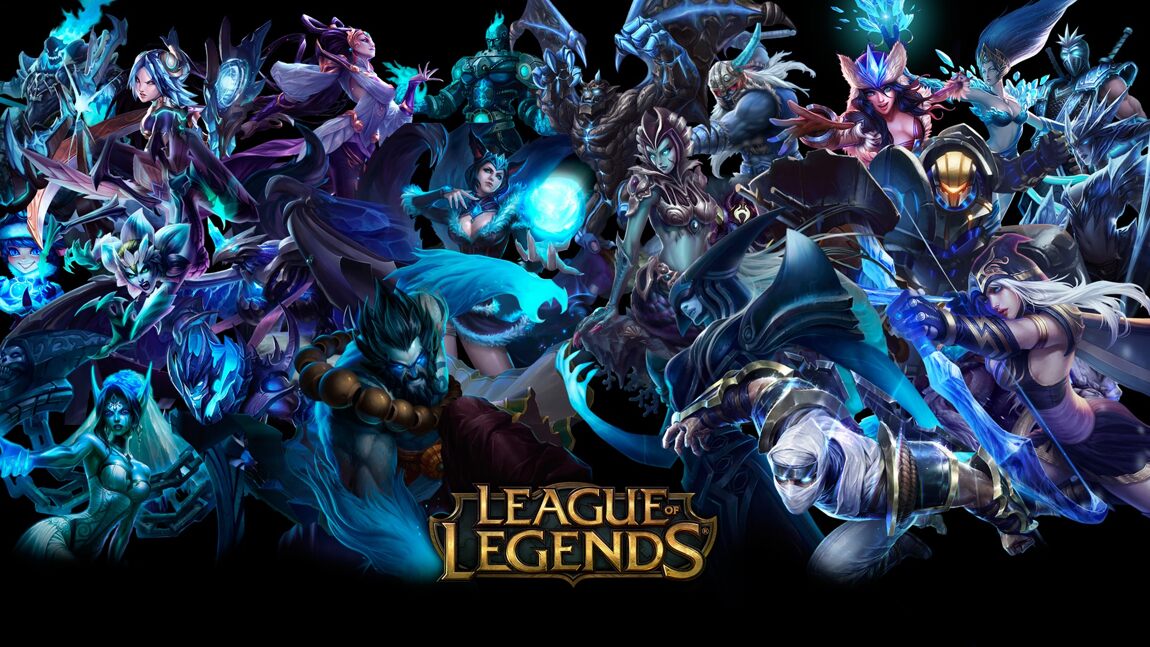
League of Legends universe
Just as thoroughly the authors approached the creation of the game's universe. Magazines, stories, videos, comics, an invitation to other developers to create their own projects on this world, even an animated series was announced - Riot Games is true to its principles. They created not even one, but several worlds - it's a multiverse.
The main events are unfolding in Runterra, on the continent of Valoran, which from the beginning was shaken by numerous conflicts, and the main weapon to resolve disputes in them was magic. The main rivals are the city-states of Demasia, where they rely on nobility and honor, and Noxus, where they value cunning, ruthlessness and strategic flair. They are not currently engaged in active wars, but are always ready to take advantage of an advantageous moment to spoil the lives of their neighbors. There's also the technologically advanced city of Piltover, and in Zaun they are no strangers to dark experiments involving the same technology. In the snow-covered Frelljord there is a civil war for a long time in the struggle for the royal throne. There are other cities, states, and islands. And from the parallel Warring Abyss monsters are coming to Valorant.
Political intrigue and conflict, especially between Demasia and Noxus, has bored the powerful sorcerers, and they created the Institute of War and the titular League of Legends so that it is on the fields of the league (the Field of Justice) that political conflicts are solved - solved in an orderly manner and without others suffering. To do this, the so-called Summoners from each side of the conflict release their heroes into specially built arenas, where battles are fought according to special rules.
In 2014, the authors updated the original canon and began to focus not on faceless summoners and powerful sorcerers, but on champions, that is, on heroes and their own stories, so that they no longer seem like puppets in foreign hands. This allowed the world of League of Legends to be filled with more lively, vivid comics and stories in the genre of adventure literature.
The main events are unfolding in Runterra, on the continent of Valoran, which from the beginning was shaken by numerous conflicts, and the main weapon to resolve disputes in them was magic. The main rivals are the city-states of Demasia, where they rely on nobility and honor, and Noxus, where they value cunning, ruthlessness and strategic flair. They are not currently engaged in active wars, but are always ready to take advantage of an advantageous moment to spoil the lives of their neighbors. There's also the technologically advanced city of Piltover, and in Zaun they are no strangers to dark experiments involving the same technology. In the snow-covered Frelljord there is a civil war for a long time in the struggle for the royal throne. There are other cities, states, and islands. And from the parallel Warring Abyss monsters are coming to Valorant.
Political intrigue and conflict, especially between Demasia and Noxus, has bored the powerful sorcerers, and they created the Institute of War and the titular League of Legends so that it is on the fields of the league (the Field of Justice) that political conflicts are solved - solved in an orderly manner and without others suffering. To do this, the so-called Summoners from each side of the conflict release their heroes into specially built arenas, where battles are fought according to special rules.
In 2014, the authors updated the original canon and began to focus not on faceless summoners and powerful sorcerers, but on champions, that is, on heroes and their own stories, so that they no longer seem like puppets in foreign hands. This allowed the world of League of Legends to be filled with more lively, vivid comics and stories in the genre of adventure literature.

Game rules and modes
So what are they, these special rules by which League of Legends arena battles resolve conflicts on Valoranta? For obvious reasons, they are generally similar to those in DoTA 2. So, in the main mode, there are two bases, the Nexus, at opposite ends of the Caller Ravine map. Players divide into two five-on-five teams, pick their own champions, and try to get to the enemy Nexus to dismantle it into bricks or whatever it's made of.
Along the way, you'll have enemy towers firing on the attackers, and computer-controlled monsters (called minions here) who run out of their base at regular intervals and run into the enemy's one with pitchforks. Super Minions can also appear, but only if the tower-protected Inhibitors, who do not attack themselves but are able to heal and regenerate themselves, are essential objects for base defense.
Along the way, you'll have enemy towers firing on the attackers, and computer-controlled monsters (called minions here) who run out of their base at regular intervals and run into the enemy's one with pitchforks. Super Minions can also appear, but only if the tower-protected Inhibitors, who do not attack themselves but are able to heal and regenerate themselves, are essential objects for base defense.
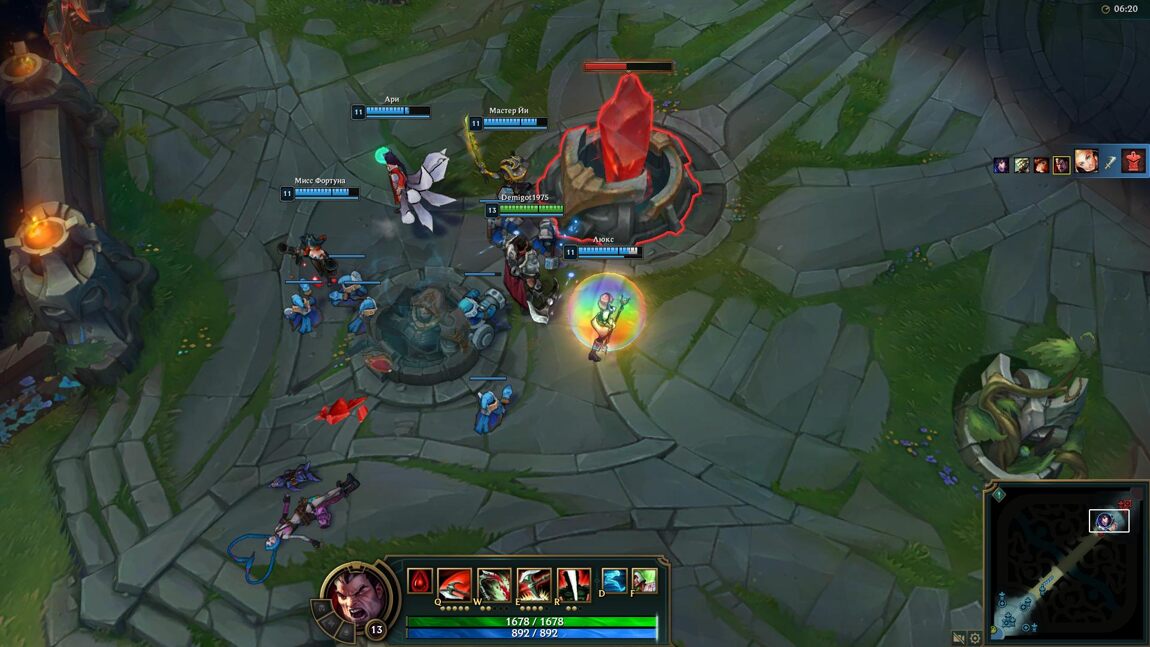
There are three lines on the map - top, middle and bottom. Plus the forest, where neutral monsters and bosses live. So, the task of the players is to correctly allocate to the lines, taking into account the characteristics of their champions, their abilities and roles. For example, the champions ("foresters") who can effectively destroy neutral monsters should go to the forest, which brings gold to the team from the first minute and allows better control of the game, interacting with all three lines. After all, there are three unique neutral bosses in the forest, and killing them gives permanent boosts to the champions or the entire team.
By playing and killing and performing useful actions, all champions unlock and pump up skills - several common ones and one particularly powerful, "absolute" one. In addition, they earn money to buy useful items. It's also important to match your champion with runes and summoner spells before the match itself. Runes are special enchantments, passive skills that strengthen the champion or close some gaps in his tactics. And spells allow you to support your heroes directly in battle - they heal, speed up, give a teleport or a temporary shield, wear out opponents, and so on. You can take only two spells with you, and it's better to choose them correctly depending on the class of the champion.
By playing and killing and performing useful actions, all champions unlock and pump up skills - several common ones and one particularly powerful, "absolute" one. In addition, they earn money to buy useful items. It's also important to match your champion with runes and summoner spells before the match itself. Runes are special enchantments, passive skills that strengthen the champion or close some gaps in his tactics. And spells allow you to support your heroes directly in battle - they heal, speed up, give a teleport or a temporary shield, wear out opponents, and so on. You can take only two spells with you, and it's better to choose them correctly depending on the class of the champion.

In addition to the "Ravine of the Summoners" map, there is also the "Cursed Forest" map, where the battles are in a three-on-three format. There, in fact, the same rules, but with a number of features - there are fewer towers (as well as players), but at the start of the champions have a lot more gold and useful items. And in the forest, in addition to neutral monsters and bosses, there are altars, the capture of which gives bonuses to the team.
On the map "Howling Abyss" is available mode ARAM, features which are encapsulated in the name. ARAM is an abbreviation of All-Mid All-Random, which translates into Russian as "All-Mid Line, Random Champions". Yes, on this map there's a fight only on the midline, and players can't choose their own champion - the game does it for them, randomly choosing from a list of available heroes. In addition, the champions here start the game immediately from level 3, and on the right side of the card are relics that restore health. It's quite an unusual, entertaining, and entertaining mode.
On the map "Howling Abyss" is available mode ARAM, features which are encapsulated in the name. ARAM is an abbreviation of All-Mid All-Random, which translates into Russian as "All-Mid Line, Random Champions". Yes, on this map there's a fight only on the midline, and players can't choose their own champion - the game does it for them, randomly choosing from a list of available heroes. In addition, the champions here start the game immediately from level 3, and on the right side of the card are relics that restore health. It's quite an unusual, entertaining, and entertaining mode.
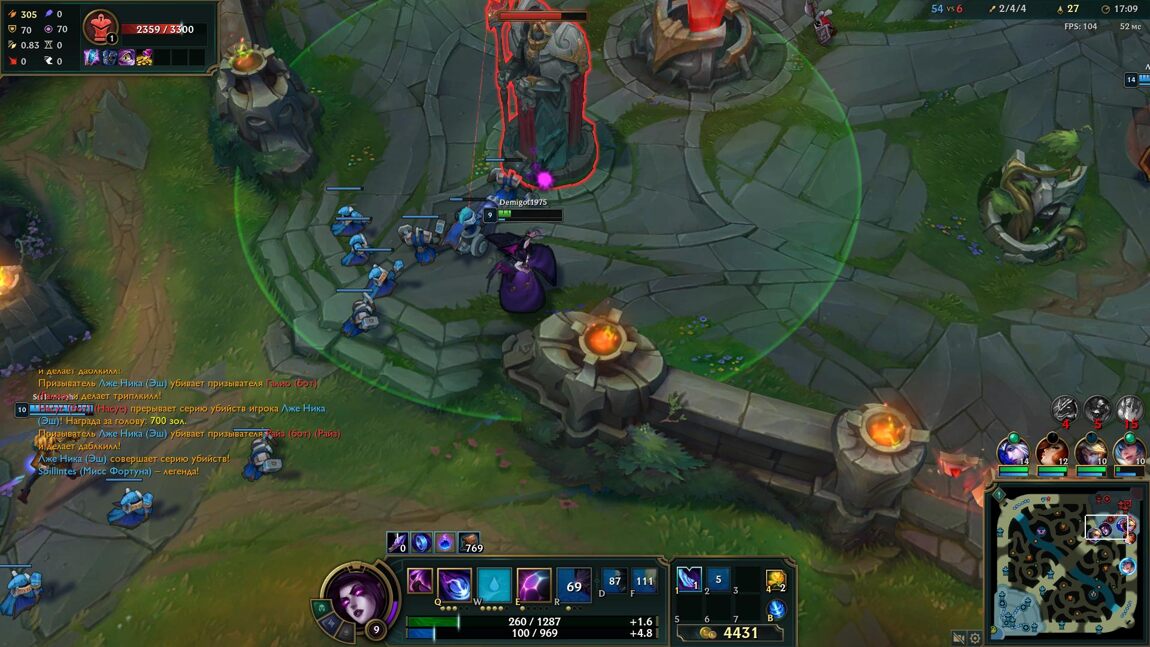
During various special events (and believe me, there are a lot of them in LoL!), so-called temporary game modes with special rules become available, which change the classic traditions of the game. For example, in the "All for One" variation, as you can guess, all conscripts play for the same champion after the corresponding vote. And in Assault on the Nexus, the rules periodically change and the champions of both teams are often forced to fight against each other.
Finally, if you're tired of the usual modes, you can enter Teamfight Tactics - a strategy game where you do not control the champions yourself, but buy them, put them on the game board and then see if they can beat the enemy's heroes. For earned money you can buy new characters and useful items for them. And you should place them on the field, buy them and put them out wisely - if, for example, you combine three of the same champions, you get a super champion, and three supers make an absolute champion.
Finally, if you're tired of the usual modes, you can enter Teamfight Tactics - a strategy game where you do not control the champions yourself, but buy them, put them on the game board and then see if they can beat the enemy's heroes. For earned money you can buy new characters and useful items for them. And you should place them on the field, buy them and put them out wisely - if, for example, you combine three of the same champions, you get a super champion, and three supers make an absolute champion.
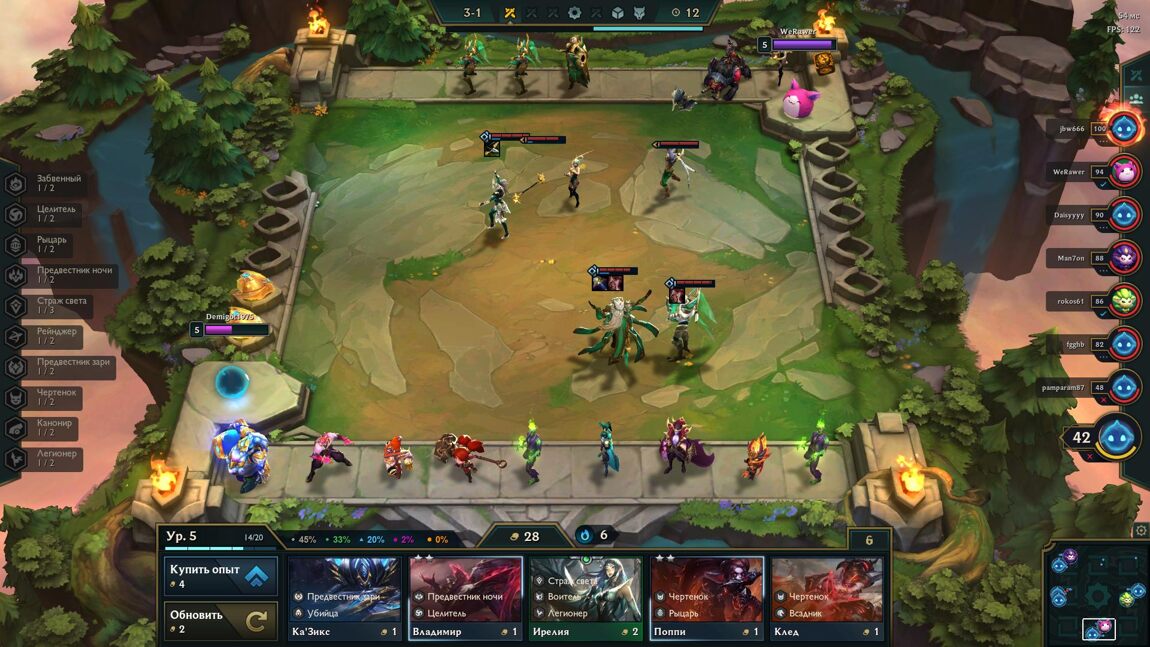
About donation and ratings
Playing in any mode, completing daily tasks (such as "Play three times in a ranked match", "Do 5000 damage" and the like), players (here they are, as you have understood, called summoners), earn experience and increase the level of their account. And this opens up new opportunities (such as new spells) and allows you to get honor capsules - and there may be not only blue essence (local in-game currency), but also shards of champions to get them and items for their customization. Ultimately, all of this allows you to expand your set of heroes and make them look unique.
You can, of course, also invest real money for which you sell a special RP currency. It can be spent in the internal store on new champions, their appearance and other stuff like icons and emotions, but this doesn't have any direct benefits - except that you can get the desirable hero or raise your level as a summoner. But a high level of your account, for example, doesn't guarantee that you know how to play your champs; it's not about money; it's about personal skill and knowledge of key aspects of the game.
At the end of the day, it's not your drafting level, or the number of champs or currency in your account that determines how cool you are in League of Legends, it's your rating. To do this you need to actively participate in ranked matches, win, earn so-called league points, move from division to division and raise your rank. All of this happens as part of the next season, and at the end of it, those who have reached the highest ranks receive their well-deserved awards.
You can, of course, also invest real money for which you sell a special RP currency. It can be spent in the internal store on new champions, their appearance and other stuff like icons and emotions, but this doesn't have any direct benefits - except that you can get the desirable hero or raise your level as a summoner. But a high level of your account, for example, doesn't guarantee that you know how to play your champs; it's not about money; it's about personal skill and knowledge of key aspects of the game.
At the end of the day, it's not your drafting level, or the number of champs or currency in your account that determines how cool you are in League of Legends, it's your rating. To do this you need to actively participate in ranked matches, win, earn so-called league points, move from division to division and raise your rank. All of this happens as part of the next season, and at the end of it, those who have reached the highest ranks receive their well-deserved awards.

Champions, their characteristics and roles
As of today, there are as many as 156 champions in League of Legends. All of them are divided into six classes - assassin, archer, mage, warrior, support fighter and "tank". And all of them can play five roles.
"Tanks" they are "tanks" - these are the heroes that can withstand a large amount of damage. At the same time, they do relatively little damage. Their task is to be in the front line, to assault the lines and cover the rest, working as a kind of "human shield". Popular, especially for beginners, are Gnar, Poppy, Amumu and the minotaur Alistair, who can hit the ground and throw enemies up in the air, among other things.
"Tanks" they are "tanks" - these are the heroes that can withstand a large amount of damage. At the same time, they do relatively little damage. Their task is to be in the front line, to assault the lines and cover the rest, working as a kind of "human shield". Popular, especially for beginners, are Gnar, Poppy, Amumu and the minotaur Alistair, who can hit the ground and throw enemies up in the air, among other things.

"Tanks" should be covered by "Damagers" - these are champions who can deal powerful damage and quickly evade an attack or stay at a distance. But their defense is weak. This includes shooters, mages and assassins who can use stealth and invisibility skills to quickly appear behind the enemy's back, strike and hide, leaving behind traps. The best and most famous are considered Zed, Fizz, Morgana, Jinx, Caitlin, Miss Fortune, Akali, who tags enemies and throws her throwing daggers at them. Also among the shooters is Yumi the pussycat, who is able to release mouse-controlled (computer-controlled, not the kind that cats hunt) magical projectiles.
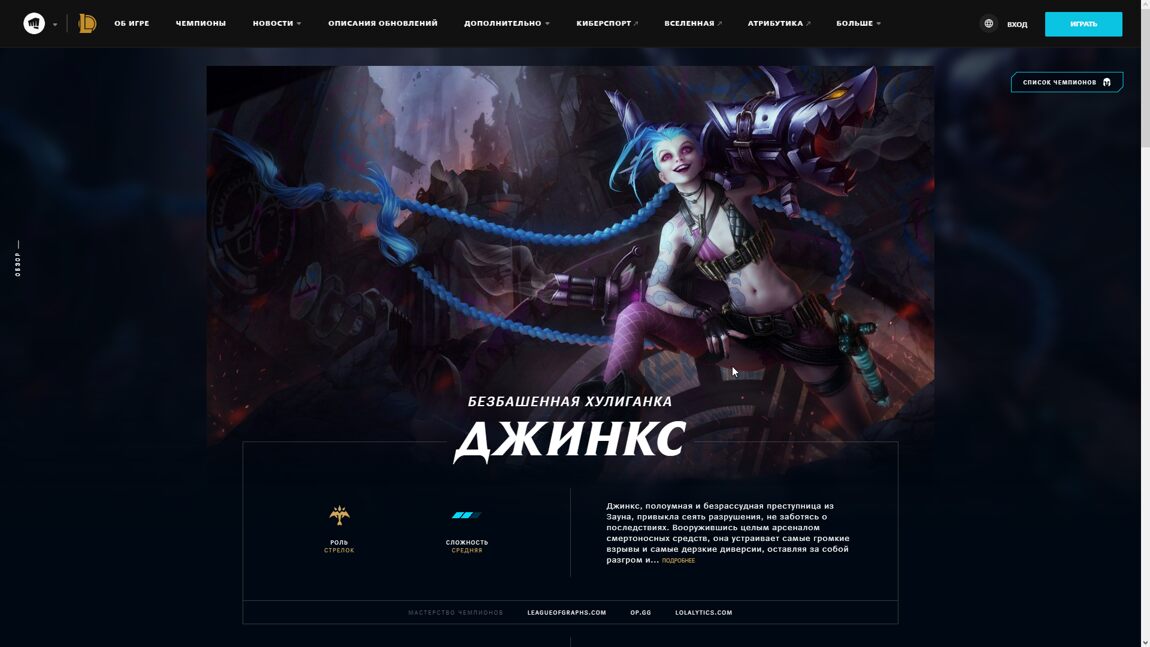
Juggernauts are warriors designed to initiate melee combat. Like tanks, they are well protected but better balanced and deal more damage. The price for such power is the warriors' slowness. Among them are Seth and Mordecaizer, whose absolute skill can do incredible things - he grabs the enemy champion and transports him to the Death Realm, a separate area where there is a 7-second battle of who's who. In doing so, Mordecaizer steals some of the target's characteristics and, if he defeats it, keeps those bonuses along with the victim's soul.

A separate role is played by the so-called "foresters" - as we have already written, their task is to destroy (farm) neutral monsters in the forest. Also, they must intelligently guerrilla from there, when you need to help an ally, set a trap or totem. Playing as them, you need to know in what order to clear the forest and have important skills like "Cara", which deals increased damage to neutral monsters. Each team usually has a single forester - it just doesn't make sense from a strategic point of view. But he is able to turn the tide of the whole game at a critical moment. Famous woodsmen include Nautilus, Warwick, Rengar and Volibir the bear, who loves to tear enemies with his claws and summon invisible lightning.
Finally, there are the support fighters, the so-called "Sapports". Their role is clear and follows from the name - to support the others, casting various protective spells, placing totems and wards, (objects, giving a large view where they stand). It's a sacrificial role - you'll have to die often to keep those on the front lines alive and gold intact. Especially popular are Sona, Nami, Lulu, and Karma, who not only shields allies, but is also able to damage enemies and even establish a bond with the enemy champion, doing him no good in every way until he breaks that bond.
Finally, there are the support fighters, the so-called "Sapports". Their role is clear and follows from the name - to support the others, casting various protective spells, placing totems and wards, (objects, giving a large view where they stand). It's a sacrificial role - you'll have to die often to keep those on the front lines alive and gold intact. Especially popular are Sona, Nami, Lulu, and Karma, who not only shields allies, but is also able to damage enemies and even establish a bond with the enemy champion, doing him no good in every way until he breaks that bond.
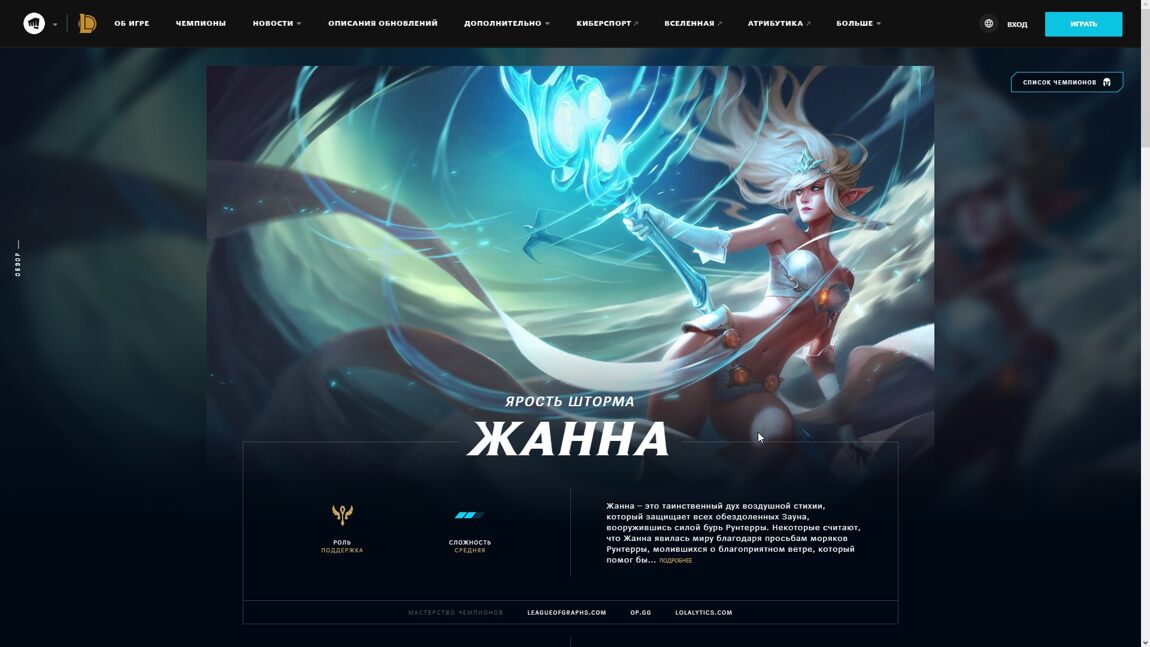
Runes and Craftsmanship
As we said before, an important mechanic when playing as champions, no matter what role they play, is the selection of runes before the match itself. These fall into five categories - Sorcery, Accuracy, Domination, Courage, Inspiration - and can enhance damage or skills, add precision to attacks or strength to the champion himself, and so on. The important thing here is to know the strengths of your champion and choose the right enchantments - after all, you can only choose one key rune and five additional enhancements. Players put the runes themselves in sets (pages), and then before the match to determine or re-assemble the most suitable for a particular hero. And it's all tied into the stories of the League of Legend universe itself - after all, the Runic Wars have long been fought on Valoranta.
Another interesting mechanic is skill, which allows you to assess how you play for this or that champion and reflects his progress in mastering it. At the end of matches, you are given a score that takes into account how that character is played by others. This is then converted into points and gives you access to new skill levels. There are a total of seven skill levels for each class. For example, Shooter can go from Hunter to Sniper, Warrior - from Brawler to Warlord, Mage - from Adept to Archimage.
Another interesting mechanic is skill, which allows you to assess how you play for this or that champion and reflects his progress in mastering it. At the end of matches, you are given a score that takes into account how that character is played by others. This is then converted into points and gives you access to new skill levels. There are a total of seven skill levels for each class. For example, Shooter can go from Hunter to Sniper, Warrior - from Brawler to Warlord, Mage - from Adept to Archimage.

What are the differences between League of Legends and Dota 2?
For many people this is an important question, given that both games operate under roughly the same rules. Well, first of all, as you have noticed in League of Legends better designed universe, there are more maps (in DOTA 2 only one) and modes, including quite unexpected and entertaining. Also, here you can choose spells and runes for your champion before the game start - there's no such thing in DOTA 2, and you have to adjust the course of the match in the very match. In LoL, when you reach a certain level of account, you will be allowed to select the champions that you don't want to see in the battle. For example, those that you're not very good at playing against, which is very convenient.

In general, it is considered that League of Legends is easier to master: fewer roles for the heroes, fewer skills for each champion (maximum five, and in DOTA 2 there are characters that have as many as 14 abilities, so they are more difficult to manage). In "Dota" you can build the whole team tactical combinations aimed at early or late game, there heroes have more flexible roles that can change on the fly, and in LoL roles and tactics are usually predefined. All of this does not mean that playing League of Legends is easy - quite the contrary. But it is a lower threshold of entry, coupled with the elaborated universe and the attention of Riot Games to support and development of the project and ensured the project a crazy popularity - play LoL more people. In addition, it often come out updates and new interesting events, there are faster fixes to various technical errors. Although DOTA 2 has a lot of advantages.

If you also decided to join League of Legends fans, you need to remember a few important things. First, at first it's better to take champions, which is easier to play, and train with them on computer opponents - there are special modes for this. If you speak for shooters and mages, then do not get into close combat, if you're a support fighter, then you need to give killing minions to those who are on the front line - they are the first to quickly earn gold and develop. Spells are better to change and pick up for each class, but there are also universal ones - for example, "teleport", "jump", "kara" (deals up to 1000 units of damage to the enemy and at the same time restores the health of your champion). To understand what runes and in what combinations you need to pick up for your heroes, feel free to try different ones and train with them again - the mechanics of both runes and spells should not be ignored. This is the most important thing - learn, train, try, watch how others play. And read the guides and useful reviews, including ours.
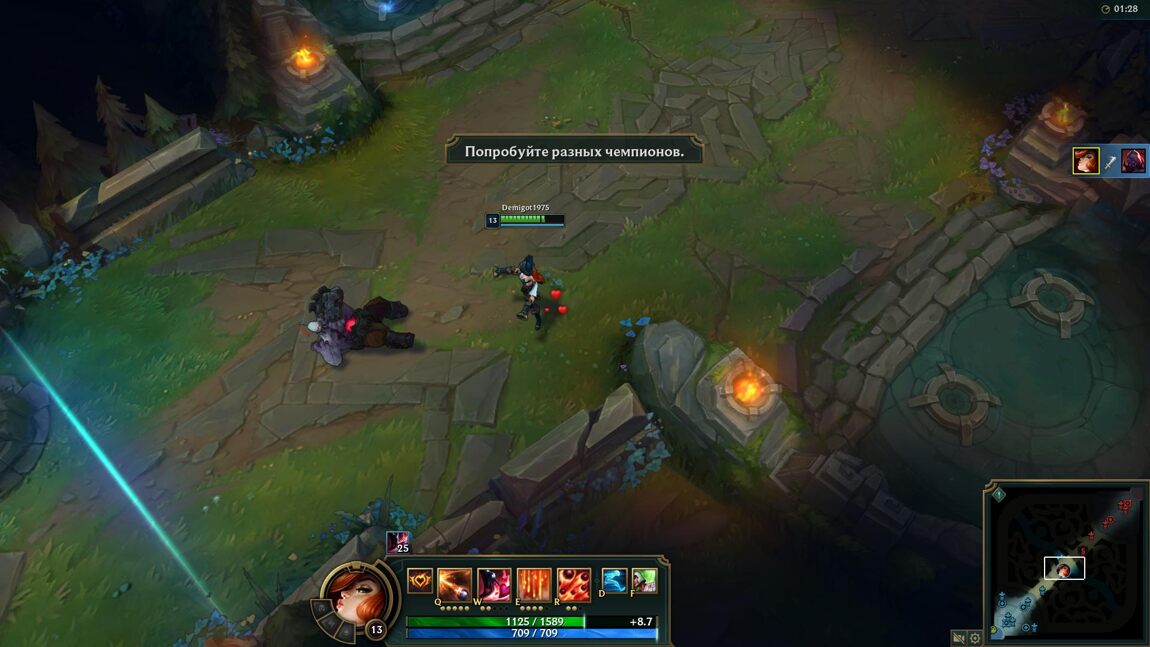
Conclusion
League of Legends is considered to be the most popular online game in the world for a reason. The highest level of support, frequent updates and interesting events, elaborated universe with its comics and series, plenty of modes and cool heroes, low entry threshold, but a lot of tactical and very difficult to master mechanics, tournaments with big prize funds - all this makes League of Legends not just a great game, but the whole phenomenon in the modern gaming industry.
31 August 2021